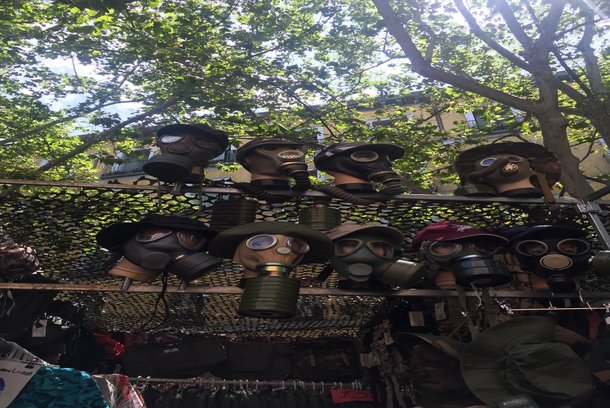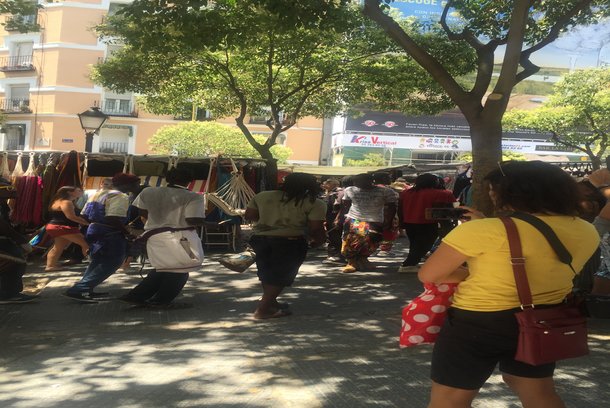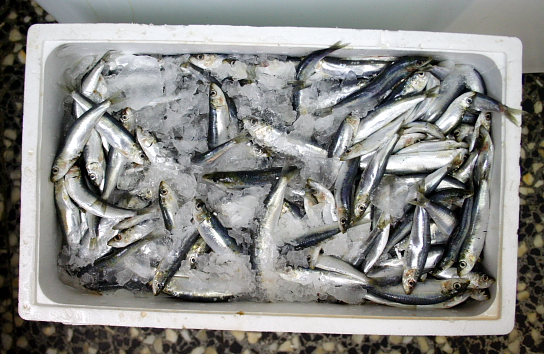Oriental scarves, leather sandals and beaded jewellery hang from the metal poles that form the skeleton of the stalls. Vintage Ramones band tees peer out towards the crowds. To the left, dozens of gasmasks line up with military precision. To the right, a Spanish gentleman strums on a guitar with a prosthetic arm. He can just be heard over cries of: “Cinco euros! Cinco euros!” Here, we are in El Rastro.
Spain’s biggest flea market unfolds every Sunday and on public holidays from 9am until 3pm. Local folklore dictates that the market inherited its name because cattle were dragged from Madrid’s slaughterhouse towards the tanneries in the Middle Ages, leaving behind a trail of blood or “rastro” in Spanish.
Today, located between Calle Embajadores and the Ronda de Toledo (just south of La Latina metro station and Puerta de Toledo station,) the melange of trash and treasure starts in the Plaza de Cascorro, and gently unfolds through the winding streets. The main branch of the market is the Ribera de Curtidores street, where over 1,000 stalls, or puestos, ripple out from this centre point.
“El Rastro is the final border between Europe and Africa, comprising diverse peoples from different countries and of differing ethnicities all searching for curiosities or bargains, sightseeing, sampling the gastronomic delights of Madrid, or simply soaking up the atmosphere,” explains German writer, Hans Magnus Enzensberger.
Handcrafts, fabrics, painting, antiques, trinkets and vintage clothing are on offer. Souvenirs start at one euro. Clothes, t-shirts and jeans begin at five euros. Antiques can reach well over fifty.
With its origins dating back to the 15th century, the market now represents a multicultural Madrid and is a must-see when visiting the city. Here, we compiled a list of ten tips for exploring El Rastro.
1. Get There Early
The market begins at 9am and continues on until around 3pm. If you want the best chance at uncovering something special, amongst the chaotic rubble of tourist merchandise and imported goods, then you should arrive as early as possible. The crowds swell between 11am and midday, making it difficult to navigate between stalls and rummage through the peculiarities.
“I really loved going to El Rastro. It’s typical Spanish culture and I liked that it is all very local. I bought two t-shirts which are cool. The people there were all very friendly,” tells Sofie, a student from Vienna, visiting Madrid.
2. Be Prepared
The winding streets become hectic as more and more buyers flood between the stalls and shops. It is essential to arrive prepared. Pack bottles of water and snacks to last while you shop, as pulling away from the flowing crowds to get into grocery stores can be a struggle. Vendors also charge more for these basic supplies on Sundays at El Rastro.
“An estimated 100,000 people show up every Sunday,” according to the El Rastro website.
3. Be Cautious
It is important to be vigilant and aware of the prescence of pickpockets at the market. Like any market event, you should avoid carrying around valuables like expensive cameras or mobile phones. It is best to carry a bag that zips tightly and closes shut. If you prefer a backpack, then hold it to the front of your body. Using coins and smaller notes is safer, and also makes it easier for vendors to distribute change.
“El Rastro is a thriving mass of vendors, buyers, pickpockets and the generally curious,” Anthony Ham writes in Madrid: City Guide.
4. Explore The Side Streets
The main street of El Rastro contains tourist merchandise and novelty items. The surrounding, smaller side streets offer unique goods: antiques, vintage clothing, paintings and trinkets. Head towards the square named Plaza de Vara de Ray. Trumpets, banjos and clocks hang from the stall walls. Dozens of horseshoes, gold plated mirrors and china teapots line the pavement. Shops on Mira el Río Alto, Mira el Río Bajo, Carlos Aniches are other nearby streets specialize in selling antiques and trinkets. Calle San Cayetano, or colloquially named Calle de los Pintores, translates to “Street of the Painters” and here you can find a range of artwork on sale. Nearby Nuevas Galerias and La Galeria Piquer contain individual shops worth checking out, both selling furniture and household goods.
“The antique are perhaps the most exciting. Here, the items are very special. Spanish things and treasures you can only uncover in Madrid.” Mercedes, a long-time vendor selling bags at the market, explains.
5. Negotiate
Many vendors cut their prices if you are willing to negotiate for a better deal. If you can speak Spanish, then you are at an advantage, but the majority of dealers can explain prices in English and other languages. Learn ¿Cuánto cuesta?/ How much is it? to aid your negotiations. Having said that, for lower range goods, some vendors have set prices and will not stray away from them.
“I bought an antique lock and key for my boyfriend back home. I wanted to get him something unique, and the antique selection was very impressive, ” says Kellie, 22, a recent graduate from Canada visiting Madrid for the first time.
6. Scour the Stalls
Even at the more central stalls, you are able to excavate something worthwhile, beneath the plastic toys and colourful underwear. Always keep an eye out when passing stalls, even if they do not seem of much interest. Sometimes unique treasure can be hidden amongst junk. Again, if you venture to the market early enough, you have a better chance of being able to properly forage.
“For every 10 pieces of junk, there is a real gem (a lost masterpiece, an Underwood typewriter.” Anthony Ham writes in Madrid: City Guide.
7. Try Any Clothes On
El Rastro boasts a variety of clothes: traditional Spanish flamenco dresses, vintage Levi demin jackets, retro army jackets and the expected tourist t-shirts stamped with I Heart Madrid. Sizes vary from stall to stall. Many of the clothes sold are vintage and stem from all over the world, so standard sizes change and differ between each item. If you want to buy any clothing, then you should try it on. Vendors allow customers to do so and are mostly happy to help.
8. People Watch
Bordering La Latina, and nearby neighbourhood Lavapiés, with the highest immigrant population in Madrid, El Rastro is a melting pot of rich culture and heritage. South American, South Asian and African influences are clear. The result: a variety of peformers and street musicians play as the market winds down. El Rastro represents a diverse Madrid, and brings together hundreds of nationalities, so people watching offers an international experience.
9. Have Lunch
Situated in the La Latina district, El Rastro is surrounded by restaurants and bars.Typical Spanish tapas bars (try Los Caracoles) sit comfortably between Indian restaurants (check out Bombay Blue) and Arab style tea houses. Local institution, Bar Santruce, sells fresh fish dishes and has been in the area since 1977, specialising in grilled sardines. Check them out.
“The sardines served here are some of the best grilled fish in the neighborhood, if not the city, and this place is heaving on Sunday afternoons for good reason,” according to Madrid T and T, a tourism guide in the area.
10. Plan a Siesta
Exploring El Rastro is tiresome. The long winding streets with masses of buyers and tourists packed together, especially under the grueling Spanish sun, can be a strenuous combination. As the market winds down at 3pm, head home for a siesta and refuel after hours of treasure hunting.
What do you think? Have we missed any important tips for exploring El Rastro? Let us know in the comments below! If you are visiting Madrid, check out this article on the best tapas in the city here.















